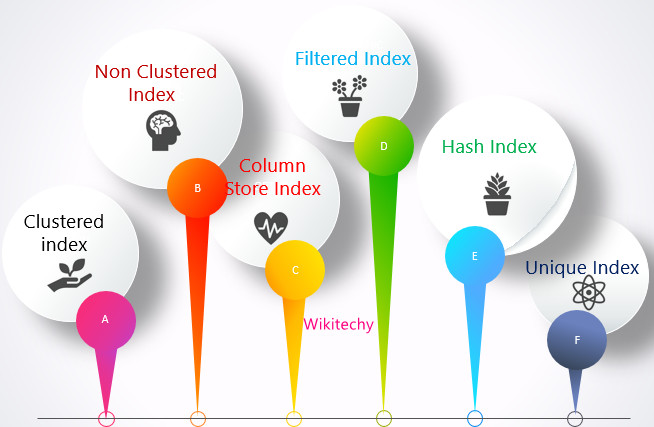There are various types of indexes in SQL server:
- Clustered Index
- Non-Clustered Index
- Column Store Index
- Filtered Index
- Hash Index
- Unique Index

Clustered Index
- Rows of data are sorted and stored data in a table or view depending on the central values by clustered index.
- Each table can have one clustered index as it enables the user to store the data in a single order.
- Data is sorted and stored in gathered index, so if we see a data in a table sorted means it is arranged with clustered index.
- If a table contains clustered index, it is called as clustered table.
- When a huge data needs to mdified in a database we use clustered index.
Non Clustered index
- Non clustered index are structures that are seperated from the data row.
- This type of index contains non clustered key values and those pairs has a pointer to that data row.
- In non clustered index, arrow from an index row to data row is called as row locator.
- Row locator structure identifies whether the data pages are in the form of clustered table or heap.
- Row locator is termed as cluster index key in clustered chart.
- User can easily add non key columns to the leaf level in a non clustered index as it byepasses the existing index key limits to perform fully covered indexed queries.
- A non clustered index is created to improve the overall performance of frequently asked questions which cannot be created in clustered items.
Unique Index
- It enables users to confirm that every row in the table is unique in one way or other by checking if the indexing key contains any duplicate values.
- When user wants to use the unique character of data he can use unique index.
- Unique index allows indidviduals to ensure that data integrity of each defined column of the table in the database.
- It provides additional information about the data table which is helpful for query optimizer.
Filtered Index
- This index is created when column has only a small number of relevent values for queries on the subset of values.
- When table contains hetrogeneous data rows, a filtered index is created in sql for one or more data types.
- Filtered index is indicate even when query optimizer does not cover any query.
- Filtered index indexes the portion of rows in a table, it applies filter on index by improving the overall performance of the query.
- Filtered index helps to reduce the maintanence cost and storage cost
- Overall impact of data modification is less in filtered index as it is updated only when a new record is inserted or when the data of the index is impacted.
Column Store Index
- Column store index is standard form of index when it comes to storing and querying the large data warehousing tables.
- This index was designed for the impovement in the performance of query in case of workloads with vast data.
- Data are stored as column based format.
- It reduces overall storage cost and provides high level compression of data.
- Since data compression happens, user can efficiently perform input and output functions for a high performance result.
Hash Index
- Hash index is simply an array in sql that contains pointer slot and a row on each slot.
- Hash index use hash function F(K,N) where K is critical and N is number of Buckets.
- Function maps out to key corresponding to the bucket of the hash index.
- Each hash bucket index contains 8 bytes which is used to store the memory address of the linked list of critical entities.

